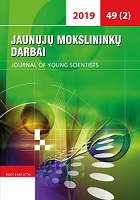ŠEŠIŲ SAVAIČIŲ TRUKMĖS PLIOMETRINIŲ ŠUOLIŲ PROGRAMOS POVEIKIS JAUNŲJŲ KREPŠININKŲ GREITUMUI, GREITUMO JĖGAI IR VIKRUMUI
THE EFFECT OF A SIX-WEEK PLYOMETRIC JUMP PROGRAM ON YOUNG BASKETBALL PLAYERS‘ SPEED, SPEED POWER AND AGILITY PERFORMANCE
Author(s): Lauras Grajauskas, Gediminas Jakutis, Danguolė RazmaitėSubject(s): Health and medicine and law, Sports Studies, Pedagogy
Published by: Vilniaus Universiteto Leidykla
Keywords: plyometric workout; young basketball players; speed; speed power; agility;
Summary/Abstract: The aim of this study was to determine the effect of a 6-week plyometric exercises program on young basketball players‘ speed, speed power and agility. Eleven basketball players aged 17–18 participated in the study. They were divided into a control (n = 5) group and an experimental (n = 6) group. The basketball players of the experimental group made plyometric jumps training twice a week after their main basketball workouts. The program was based on the recommendations of T. J. Piper and L. D. Erdmann (1998). The number of various jumps per week varied from 180 to 280. The rest intervals lasted 45 seconds between repetitions of exercises and 2 minutes between sets of exercises. Anthropometric measurements were performed according to the recommendations of K. Norton et al. (1996). A 20-meter high start test was used to determine speed, counting the first 10 meters running time (Duthie et al., 2006; Foran and Pound, 2007). The vertical jump height was measured using the multifunctional equipment Newtest (Finland) of the jump measurement module, based on C. Bosco et al. (1983) methodology. The T-test was used to determine agility (Pauole et al., 2000). After 6 weeks, the 10-meter running time in the experimental group decreased by 2.86 % (p < 0.05) and the 20-meter running time by 1.99 % (p > 0.05). The speed test results of the control group did not change significantly over the same period (p > 0.05). The jump height of the experimental group improved by 9.31 % (p < 0.01), while the control group showed a slight change (2.07 %; p > 0.05). The improvement in agility in the experimental group was 2.71 % (p < 0.05), whereas the control group showed a small change (0.62 %; p > 0.05). The experimental 6-week program had the greatest impact on young basketball players‘ speed power and agility. The effect on the speed, although small, was statistically significant.
Journal: Jaunųjų mokslininkų darbai
- Issue Year: 2019
- Issue No: 2 (49)
- Page Range: 14-19
- Page Count: 6
- Language: Lithuanian

